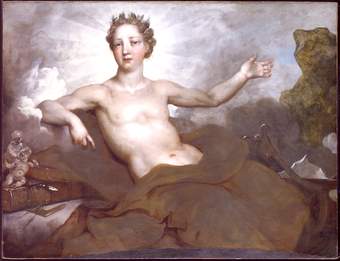
Fig.1
Unknown artist, France
Apollo c.1720
Oil paint on canvas
899 × 1168 mm
T00894
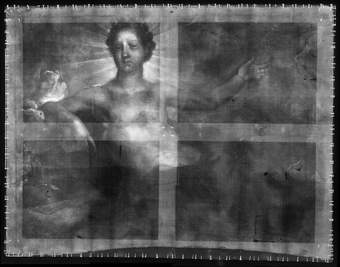
Fig.2
X-radiograph of Apollo c.1720
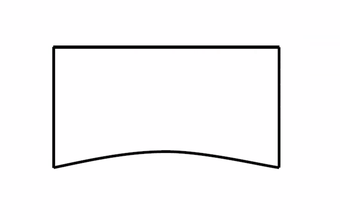
Fig.3
Suggested original format
This painting is in oil paint on canvas measuring 899 x 1168 mm (fig.1). The plain woven canvas, with 16 vertical x 12 horizontal threads per square centimetre, appears to be of high quality with few slubs. It is now lined with glue paste adhesive onto a secondary canvas and is attached to a seven membered pine stretcher, which seems contemporary with the lining. The tacking edges at the top and sides are not extant but part of the bottom tacking edge has been incorporated into the plane of the composition, and provides some evidence of the original format (fig.2). The bottom tacking edge now arches into the picture plane, suggesting that the original stretcher had a curved bottom edge; a corresponding stretcher bar mark in the painting some 50 mm above the curved edge reinforces this probability. When the painting was cleaned at Tate in 1967, later paint covering this original tacking edge was removed and replaced with neutral retouching. The off-centre placement of this feature, together with examination of the cusping and the marks from the original stretcher bars suggest that originally the painting would have extended more on the right side and perhaps a few millimetres on the left.1 There is cusping on the left edge but none on the right; there is no evidence for a stretcher bar mark at the right, whereas on the left there is a bar mark approximately 35 mm in from the outer edge. At the top the regularity of the cusping indicates that the top of the painting would always have been straight; the bar mark there is approximately 40 mm in from the edge. This format strongly indicates that this painting was a decorative piece intended for an architectural setting, such as an overdoor panel, its shape as in fig.3.
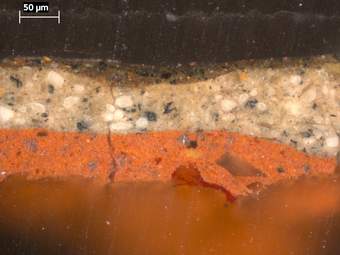
Fig.4
Cross-section taken from the edge of the lyre, 54 mm from the right edge and 9 mm in from the bottom edge, photographed at x260 magnification. From the bottom upwards: bright red positive stain for protein from acid fuchsin, for the animal glue size on the canvas; red ground; grey priming; brown paint of lyre; greyish brown paint of lyre, probably applied wet-in-wet with the layer below; varnish
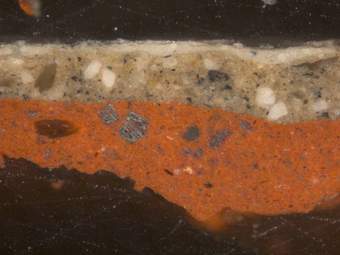
Fig.5
Cross section taken from the sky, 6mm from the top and 82mm from the right, and photographed at x260 magnification. From the bottom of the sample upwards: red ground; grey priming; pale blue sky paint; white scumble; varnish
The ground is red, probably oil pigmented with red earth with small additions of lead white, yellow and black. During treatment in 1967 it was mentioned that this layer was potentially vulnerable to moisture; staining of cross-sections for protein, however, was negative, so it may be that the red mixture was only lightly bound with oil (fig.4). The red ground layer is covered with opaque grey priming (fig.5). This layer is made up of lead white, charcoal black and glass with additions of red earth, yellow, vermilion, chalk, red/brown lakes and a little green, all bound together with oil.2
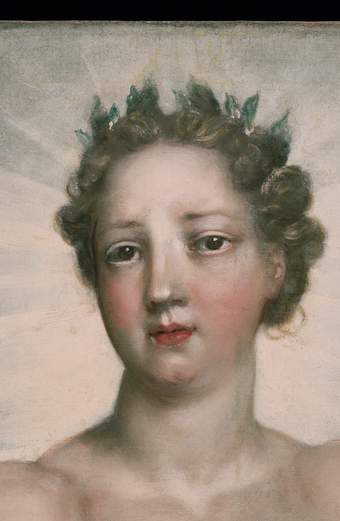
Fig.6
Detail of head and sky of Apollo c.1720
Infrared examination did not reveal any underdrawing but suggested the use of reserves, except for final details such as the callipers, which were painted over the books at the left. The figure seems to have been laid down with a thin brown, tonal undermodelling or ébauche. This is visible in areas of the face, in shadows where the grey priming is toned with a thin brown wash. Otherwise, the picture is painted very directly with only one or two layers of paint, usually applied wet-in-wet, followed here and there by a glaze or scumble or a little impasto highlight (fig.6).
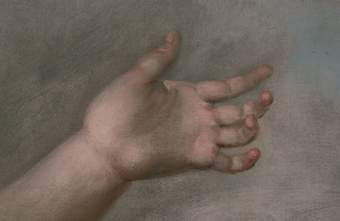
Fig.7
Detail of raised left hand and the sky of Apollo c.1720
A minor artist’s alteration is evident in the sitter’s left hand, where the third finger has been shortened slightly and the original tip incorporated into the middle finger (fig.7). Other very slight alterations have been made to the profile of Apollo’s body, such as his chest, which was extended over the drapery at the right, and his shoulder, which has been slightly enlarged. The inscription on the spine of the book has also been altered (the writing changes from French to English) to read ‘his universe’, but this is unlikely to be an artist’s pentimento and there is no evidence of an earlier inscription. Mechanical abrasion of the paint, along with the increasing transparency of the oil paint over time, has revealed other changes the artist made to the composition, such as the extension of the mountain over the sky and the sitter’s drapery over the table cloth and over the sky at the left.
The artist’s palette consists of lead white, charcoal and black (probably bone), red ochre, vermilion, orpiment, yellow ochre, sienna, red lake, an unidentified green (probably verdigris), ground glass, chalk and probably azurite, smalt, and indigo. Ground glass has been found as an additive to all the colours sampled, sometimes present with chalk; this may help to explain the stiff texture of the paint in areas such as the sky and flesh. Examination of cross-sections in ultraviolet light revealed fluorescence that suggests an oleo-resinous binding medium and/or the use of a drier in the paint medium
The painting was given several spray coats of the stable, synthetic varnish Paraloid B-72 after cleaning in 1967.
March 2020
